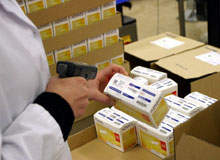Tracking the Drug Trail
Counterfeiting and fraud are significantly large risk factors when it comes to the safety of pharmaceutical products. Huw Kidwell follows the latest in developments in the pharmaceutical supply chain that are helping save lives through proper track and trace technologies.

Pharmaceutical companies, regulatory agencies and governments are becoming increasingly concerned about fraud and counterfeiting throughout the pharmaceutical supply chain, especially with the cost of drugs going up. As a result, governments are eager to protect patients from counterfeit medication, save on the costs of fraud and introduce regulatory systems throughout the drug supply chain which can afford full accountability right back to the production facility.
Data has long been incorporated into drug packaging to accomplish these goals, but only to a partial degree with embossed lot numbers, expiry dates and even Braille identification in addition to linear bar codes.
Over the last three to five years technology has been developed that makes it possible to track and trace pharmaceutical units, even down to item level. Radio frequency identification (RFID) technology, 2D matrix codes, scanning technology and sophisticated databases now offer more accountability right throughout the supply chain.
Consequently, the implementation of track and trace systems for pharmaceuticals is becoming more important as countries make it a legal requirement.
For example, Turkey will require track and trace by 1 January 2009 and California is requiring the technology by 1 January 2011.
But different methods for this are arising depending on where in the world operations sit, due to the difference in packaging standards. Europe is favouring 2D data matrix codes to encode information while the US is tending more towards RFID. RFID has other advantages in that it can be used to monitor conditions such as temperature during transport of the drugs.
TABLET FORMATS
One of the problems with track and trace for pharmaceuticals across the world is the way drugs are dealt with on an item level in Europe and the US. In Europe blister packs are favoured, but the problem with these is that the blister packs can be cut to make up odd numbers of medication. In the US solid dosage forms are distributed as containers of tablets and these can only be coded on the container and not on a per-item basis.
Combining methods of coding for both end solutions has, in the past, been the biggest challenge. There are two kinds of new technology working towards coding each format of dispensing.
Laser marking solution company Datalase has developed a system where an inactive compound can be added to the tablet formulation.
Following this, each tablet produced can be marked by a low-energy carbon dioxide laser with identifying lot numbers and even expiry dates. This process might be expensive to implement with the outlay for new precision equipment but solves the per-item marking problem for the US market.
Domino Printing Sciences European business development manager Tony Walsh says his UK-based company has come up with another solution – marking each individual blister (containing a tablet) with individual expiry dates and lot number coding.
“This system can be accomplished by using already-installed blister packing equipment along with some retrofitting of equipment and Domino software,” Walsh says. “This means that if blister packs are cut up to make up numbers of medication in a repackaging scenario each item is still fully coded.”
LEVEL TRACKING
Pharmaceutical manufacturing company Seidenader Vision has also developed a system – the SATrack and Trace. Seidenader says is a fully integrated coding line which labels cartons with the required coding label bearing a 2D matrix code and also four pieces of fully readable information including lot number, expiry date, ERP code and serial number
The company’s European marketing manager Guenther Bauer says the SATrack and Trace system has been designed especially for the Turkish market.
At each level of packaging, such as when cartons are packed into a secondary carton and then into a case and finally into a pallet, a new label is printed to encompass the coding of whatever cartons have been compiled into the new package and a camera makes a record of each label – these include SUSC standard unique serialised codes.
Bauer says this entire process is administered by the SA control and SA data centre software so that the whereabouts of each individual carton is known.
“The advantages of SATrack and Trace are that the system is very open and flexible and can support a wide range of different requirements, we are even ready to implement RFID via this system when it is required,” he explains. “At each stage the products can be checked; it just remains to decide where the checks are to be made to authenticate the products – who wants to take the responsibility.”
THE DOMINO EFFECT
There are many examples of how these technologies have helped make pharmaceutical manufacturing safer for the consumer. For example, Domino took part in a project to implement an electronic product code (EPC) track and trace drug system for the National Centre for Hereditary Coagulation Disorders in Ireland (NCHCD). GS1 Ireland provided electronic barcoding technology for the scheme.
The system was designed to carry out 100% track and trace of drugs administered to haemophilia patients at St James’s Hospital in Dublin. The pilot scheme for this has been observed by the FDA and EU Commission. The trial allowed end-to-end traceability of haemophilia medication, which promoted secure deliveries, stock optimisation and greater patient safety.
The track and trace system uses state-of-the-art electronic barcoding technology to trace expensive and time-sensitive clotting factor concentrates (CFCs) used to treat haemophiliacs. The integrated EPC technology assigned a unique number to every single item from the manufacturing line, allowing each company in the supply chain to track products at the item level in real-time throughout the cold chain storage and delivery process.
The trial was promoted by Dr Barry White, director of the NCHCD, after he became concerned about the safety of medication for haemophiliacs. According to Walsh, White was concerned some instances of contamination of blood products-one of the most catastrophic medical complications of the last century-could have been due to defects in the supply chain.
“There were considerable difficulties in identifying who had received the infected CFCs and in recalling all the contaminated products,” Walsh says.
“This 100% item-level track and trace solution is a tremendous breakthrough and heralds a new area for patient safety. Tracing blood products accurately throughout the supply chain is absolutely vital to ensure the safer administration of haemophilia drugs.”
Walsh says through using the correct track and trace methods and technologies, it can be guaranteed that the right patient receives the right dosage of the right blood product, at the right temperature and at the right time – every time.
The technology is now available to implement track and trace systems and process the vast amount of coded information for each item. Regulatory bodies and pharmaceutical companies have now got to consult over what information needs to be incorporated into track and trace systems via the various coding methods such as 2D matrix codes and RFID, and at what level. In the future perhaps a world standard can be adopted for coding and track and trace systems that would allow easy transport of drugs worldwide.
What's Your Reaction?

































